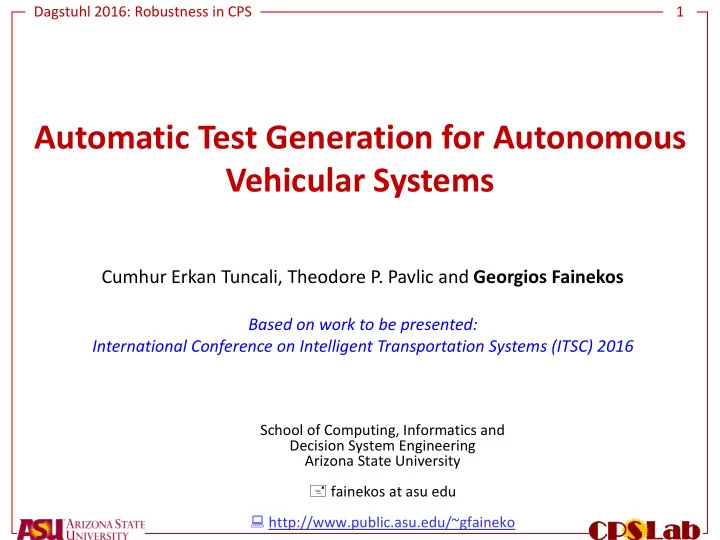

Dagstuhl 2016: Robustness in CPS 1 Automatic Test Generation for Autonomous Vehicular Systems Cumhur Erkan Tuncali, Theodore P. Pavlic and Georgios Fainekos Based on work to be presented: International Conference on Intelligent Transportation Systems (ITSC) 2016 School of Computing, Informatics and Decision System Engineering Arizona State University fainekos at asu edu http://www.public.asu.edu/~gfaineko CPS PS Lab
Dagstuhl 2016: Robustness in CPS 2 Autonomous Driving Mercedes Google Volvo Toyota CPS PS Lab
Dagstuhl 2016: Robustness in CPS 3 Autonomous Driving Current (winning) strategy: 1. Use professional drivers to train deep NN 2. Collect as much data as possible so that you do not need humans for supervision Mercedes Google 3. Deploy vehicles and continue collecting knowledge Main reasoning for the approach: You cannot possibly predict and program the vehicles for every possible situation so you have to learn and adjust. Volvo Toyota CPS PS Lab
Dagstuhl 2016: Robustness in CPS 4 Autonomous Driving Some obvious questions: 1. Do learning methods work for every vehicle (dynamics) or each car model will need different training process? What about new car models? 2. If NN/ML is the winning approach, then how can we tell (after deployment) if there concerning “corner” cases? 3. How do we achieve further levels of automation for more efficient transportation systems, e.g., platooning, intersection navigation, vehicle coordination, etc? 4. How do we check if cooperating vehicular systems are robust to disturbances? CPS PS Lab
Dagstuhl 2016: Robustness in CPS 5 How do we measure robustness? Euclidean distance or other Lane dependent measures norms do not work also do not work TTC: TTC: small number Time-to-Collision (TTC*) : Time required to collision with current heading and velocity *J. C. Hayward, “Near -miss determination through use of a scale of danger,” Highway Research Record, no. 384, 1972. CPS PS Lab
Dagstuhl 2016: Robustness in CPS 6 What if we are searching for non-robust behaviors? Our claim: We need to detect and robustify “boundary” situations. CPS PS Lab
Dagstuhl 2016: Robustness in CPS 7 Robustness Metric Goal is to find boundaries between safe and unsafe behavior! Minimizing the robustness function should guide the search towards the boundary Time-to-Collision (TTC)*: Time required to collision with current motion Collision speed Minimum collision (relative) severity Robustness function Simulation trajectory Minimum TTC in Maximum possible trajectory collision speed *J. C. Hayward, “Near -miss determination through use of a scale of danger,” Highway Research Record, no. 384, 1972. CPS PS Lab
Dagstuhl 2016: Robustness in CPS 8 Robustness Metric Large TTC: Small collision “risk” Collision at a maximum Collision at a small relative velocity relative velocity An example robustness function. Maximum possible collision speed = 100 CPS PS Lab
Dagstuhl 2016: Robustness in CPS 9 Problem Formulation Given: • a set of Vehicles Under Test (VUT), • a set of dummy actors (objects physically interacting with VUT in the environment, e.g., human-driven vehicles, pedestrians etc.), • surroundings (e.g., road network, weather and road conditions etc.), and the boundaries for initial conditions, states and functions defining motion (of dummy actors or VUT), compute the initial conditions and inputs/trajectories which lead to an operation on the boundaries between safe and unsafe behavior. Image from: http://www.techspot.com/news /64373-platoons-self-driving- m trucks-made-their-way- across.html CPS PS Lab
Dagstuhl 2016: Robustness in CPS 10 Framework Architecture S-TaLiRo • A MATLAB toolbox for systematic testing of hybrid systems. • Robustness metric: How far a system trajectory is from falsifying formal system requirements (negative robustness means a requirement is falsified) • Optimization methods (e.g., simulated annealing, ant colony optimization) CPS PS Lab
Dagstuhl 2016: Robustness in CPS 11 Case Study Simulation Configuration: • Two vehicles under test • One dummy vehicle • Two-lane straight road Simulation Engine: • Simulates VUT using a vehicle dynamic model • Simulates dummy vehicles using a kinematic model • Implemented in MATLAB (Can be changed to another platform) Initial Conditions: • Both VUT on the right lane separated by a distance • The dummy vehicle is on the left lane next to one of the VUT CPS PS Lab
Dagstuhl 2016: Robustness in CPS 12 Case Study Vehicle Configuration: • Critical points define the vehicle (corners, sensor positions etc.) • Sensor locations, orientation and ranges are defined • VUT controlled by a Model Predictive Controller • Dummy vehicles are controlled by a PID controller A side sensor with Blind area ! 5m range and 10° sensing angle A front sensor with 10m range and 10° sensing angle CPS PS Lab
Dagstuhl 2016: Robustness in CPS 13 Case Study Experiment Results: Seeking a trajectory for the dummy vehicle which causes a behavior at the boundary between collision and no-collision operations. (A very slow speed collision or a very near miss) (The trajectory for the dummy vehicle) (A front collision right after avoiding a side collision) CPS PS Lab
Dagstuhl 2016: Robustness in CPS 14 Where are we going with this? High level defined with π -calculus Low level defined with hybrid expressions automata More complicated sensor models Mercedes-Benz Campbell et al Modeling Concurrency and Reconfiguration in Vehicular CPS PS Lab Systems: A π -calculus Approach , IEEE CASE, 2016
Dagstuhl 2016: Robustness in CPS 15 Where are we going with this? Testing sensing and perception algorithms as part of the system. Typical Example: Traffic Light Status Detection Using Movement Patterns of Vehicles* * Campbell et al Traffic Light Status Detection Using Movement Patterns of CPS PS Lab Vehicles, IEEE Intelligent Transportation Systems Conference, 2016
Dagstuhl 2016: Robustness in CPS 16 Thank you! Questions? Eventually we will be able to trust our lives on CPS! Any opinions, findings, and conclusions or Awards: recommendations expressed in this material are those of the author(s) and do not necessarily reflect CNS-1446730 the views of the National Science Foundation. CPS PS Lab
Recommend
More recommend